The diverse and continuing evolution of Bangla

A story that has long been repeated is that Bangla derives from Sanskrit. The truth—the satya, sachcha, shacha, hacha or hasa—is much more complicated.
Some things are clear. Bangla's core—the bulk of its basic nouns like hat (hand) and pa (foot), its verbs and the way they're conjugated, the little pieces of hard-to-translate elements (and I don't mean so-called "untranslatable" words like obhiman—I mean little words like the to in bhalo korechho to!)—these were all inherited from Bangla's ancestor language. But here I don't mean Sanskrit (or technically, Old Indo-Aryan), which ceased to be a spoken language by the 6th century BCE, well before the Indo-Aryan cultural world even reached Bengal. Given this gap of over 1500 years between spoken Sanskrit and Old Bangla, what is our linguistic ancestor?
The Prakrit core and the long shadow of Sanskrit
Modern linguists describe Bangla's predecessor using terms relative to our own reality, but of course no speaker called their language "Proto-Bengali-Assamese", "Eastern Apabhrangsha" or "Spoken Magadhan Prakrit". While Classical Sanskrit was reserved for formal use, everyday communication in Medieval Bengal would have been in one or more "Prakrits", the languages that developed naturally (prakritik bhabe) from the accumulation of hundreds of years of tiny changes to spoken Sanskrit.

By the time these Prakrit languages arrived in early Bengal, they were substantially distinct from Sanskrit. For example, the complex, irregular verb system of Sanskrit—where the past tense of kar-omi (I do) is a-kar-avam (I did)—was completely scrapped in Prakrit. In fact, the way we mark past tense in Bangla today with l-based suffixes—where the past of kor-i (I do) is kor-lam (I did)—began as a Prakrit pattern using the suffix -illa. Furthermore, pronunciation had changed so much that words like satya (truth) had evolved into sachcha even by the Buddha's early Prakrit (c 500 BCE), and over a millennium later, evolved into Old Bangla shach (I'll return to this word in a moment).
The bulk of our basic vocabulary underwent exactly this process: take a Sanskrit word, make tiny changes every generation for a couple of millennia, and it becomes Bangla. These are tadbhava words, derived from Sanskrit through Prakrit to Bangla by natural evolution in pronunciation. These are distinguished from tatsama words, Sanskrit words that did not go through that evolution. But how does a 2,500-year-old Sanskrit word appear in Bangla without evolution?
Bengalis are notorious for loving Sanskrit, even more than other South Asians do (is it because Bengal was never truly Sanskrit-speaking, and this is our way of compensating for it?). So, as the elites of Medieval and Modern Bengal were already familiar with Sanskrit, they were comfortable borrowing a Sanskrit word or two (thousand) into their everyday speech, much like cosmopolitan Bengalis today draw effortlessly from English. This reintroduction of so much Sanskrit into what is effectively its linguistic granddaughter is part of what distinguishes Bangla from its closest sisters such as Assamese.
Let's return to "truth". You might have thought, ah! I know satya, we pronounce it shotto. So how does shach fit into all this? Shach or shacha is arguably our authentic word for "truth", derived from satya through the natural evolution of Sanskrit to Prakrit to Bangla, but was replaced by a cryogenically frozen satya through the Sanskritisation of written Bangla, and has since entered mainstream speech as shotto or shotti. As a result, with shotti bringing a Sanskritic air of sophistication, our own shacha became associated with being uneducated. You'll hear it in a further evolved form, in Dhakaiya hacha or Sylheti hasa, but you might not have realised that this is not just a local word, but was in fact previously the only Bangla word for "truth", before satya was revived after some 2,500 years after its natural passing. The same thing can be said for rat vs ratro (night), shaj vs shondhe (evening), majhe vs moddhe (within), nun vs lobon (salt): countless native Bangla words compete for linguistic space against their own Sanskrit grandparents.
The role of pre-Indo-Aryan languages
We know unfortunately little about what was spoken in the kingdoms of ancient Bengal, before adopting the incoming Prakrits of the Indo-Aryan culture expanding down the Ganges. However, vestiges of those non-Indo-Aryan languages are presumably baked into what makes our Bangla itself different from other Indo-Aryan languages, since of course, the majority of the proto-Bengali population would have only eventually learned Prakrit as a second language. Many of us know from personal experience that when learning a second language, you often bring bits and pieces of the accent and grammar of your first language into the second. In fact, we find clues to our pre-Indo-Aryan languages in the tendency east of the Padma to pronounce chh and j as s and z (zaitese for jaitechhe), our inability to distinguish the murdhonno no, or our fondness for the ng sound (as in the name Bangla itself). It's worth noting that the minority languages of Bangladesh also have these properties, suggesting that proto-Bengalis may have shared at least some linguistic features observed in the non-Indo-Aryan languages of Bangladesh today.

Contact in the modern era
During the 200-year-long Mughal rule of Bengal, the Bangla vocabulary expanded to include Persian words for concepts in the legal system (dorbar: court, ain: law), administration (jela: districts, khajna: revenue), military (kella: fort, tir: arrow), and religion (roja: fasting, namaj: prayer). Although they amount to only three percent of words in a typical Bangla dictionary, Persian words are so firmly established they could easily masquerade as native to the language. Consider the following sentences, where the Persian-derived words are underlined (many of which were in turn borrowed into Persian from Arabic):
Besh gorom dekhe chadorer kono dorkar nei. Aste kotha bolchho keno? jore bolo! rastae beshi aoaj hochchhe. Choshma dao, porda shorao! khoborer kagoj porbo. Aenata shorie dealta kemon khali-khali lagchhe. Dokan theke hajarta jinish kine anlo.Golap baganṭa ami khub pochhondo kori. Jaegaṭa ashole kharap na!
Trade with the Portuguese introduced words that have become indispensable around the house, like chabi (key), janala (window), istiri (ironing), almari (wardrobe), botam (button), fita (shoelace), shaban (soap), balti (bucket), gamla (basket), and of course the indigenous names of many fruits brought from the Americas: pepe (papaya), anarosh (pineapple), ata (custard apple), sofeda (sapodilla), kaju (cashew), and countless others. But no European language has had as overwhelming a presence as English, which has successfully taken on the role previously held by Sanskrit and Persian, in providing a source for vocabulary to complement, replace, or preclude the coining of native Bangla words.
The Bangla script
The earliest form of writing in the post-Vedic Subcontinent was the Brahmi script, popularised during the 3rd century BCE reign of Asoka, who decreed that his edicts of non-violence (after a particularly bloody war) be engraved on columns across the Mauryan Empire. The very idea of writing as mass communication was novel in the Subcontinent, and on top of that, the fact that this early writing was in the local Prakrits rather than Sanskrit reflected that Asoka knew that even imperial proclamations must be in the language of the people if they are to be effective.
The Brahmi script remained stable for 700 years after those first Edicts, notably regular in its system of consonant symbols and vowel markings, with simple, angular shapes, easy to transcribe on stone columns, cave walls or copper plates. Only in the Gupta Empire of the 4th century CE did this system begin to change. In a sense, scribes never stopped using Brahmi; each generation had just made small local changes until it evolved into the myriad of scripts we see today, from Tibet to Sri Lanka and ultimately out to the Philippines.
Some of the more conscious changes to the Brahmi script arose because scribes shifted to writing Sanskrit, which although largely dormant for almost a millennium by then, saw a resurgence under the Guptas. And with its more complicated sound system, Sanskrit required changes to the script. Brahmi needed new consonants and vowels: Prakrits had one s-sound, so Brahmi only needed one letter so, but Sanskrit had three, which we still call talobbo sho, donto sho, and murdhonno sho. Symbols that we call oi-kar and ou-kar, plus two ri-kar's and even two li-kar's were derived especially for Sanskrit. And most notably, consonants had to combine not just with vowels, but also stack onto other consonants—what we now call juktakkhor or juktoborno. This expanded Brahmic system remains the core of all modern Indic scripts today, including the Bangla script.
Bangla's future
While a script can display signs of inertia, especially in the age of standardised fonts, the evolution of a spoken language never stops. Generations upon generations of speaking vernacular Sanskrit led to the many Prakrits, and from one eastern Prakrit came Bangla. The process has no reason to stop; mass media and globalisation can suffocate linguistic diversity, but it cannot stop language change. As such, Bangla will continue to grow with each generation, but how?
The once-substantial influence of Persian has largely subsided, and in its place, it appears English will continue to serve as the language from which we freely borrow new basic terms as well as technical vocabulary (which Sanskrit helps us with as well). Persian's role in religious vocabulary, however, has already been replaced by appealing to Arabic more directly, as we see in trends such as shifting from Persian Khoda Hafez to Allah Hafez.
Aside from these externally-focused trends, we can also look at change within Bangla. Each regional variety of Bangla is the local descendant of the various Old Bangla dialects that derived from eastern Prakrit. But not all varieties are treated equally; that of the Nadia-Kushtia region (in which jaitechhi becomes jachchhi: I'm going) swept across Bengal as a new standard since the 1800s, and is likely to encroach further on other regional varieties due to its exclusive position in formal education. It's commonplace to find Bengalis who can understand their grandparents' Noakhailla or Puran Dhakaiya but can only speak in this so-called "shuddho" Bangla.
Given the sheer numbers of speakers, it's thankfully unlikely that regional varieties of Bangla will disappear. But more than English, shuddho Bangla will serve as the strongest factor in shaping exactly how these varieties will change in the future. And as both a linguist and a speaker, my hope is that we document Bangla's continuing evolution without having to sacrifice its own diversity, thousands of years in the making.
Prof Sameer ud Dowla Khan is Professor at the Department of Linguistics at Reed College, USA.

 For all latest news, follow The Daily Star's Google News channel.
For all latest news, follow The Daily Star's Google News channel. 



Comments